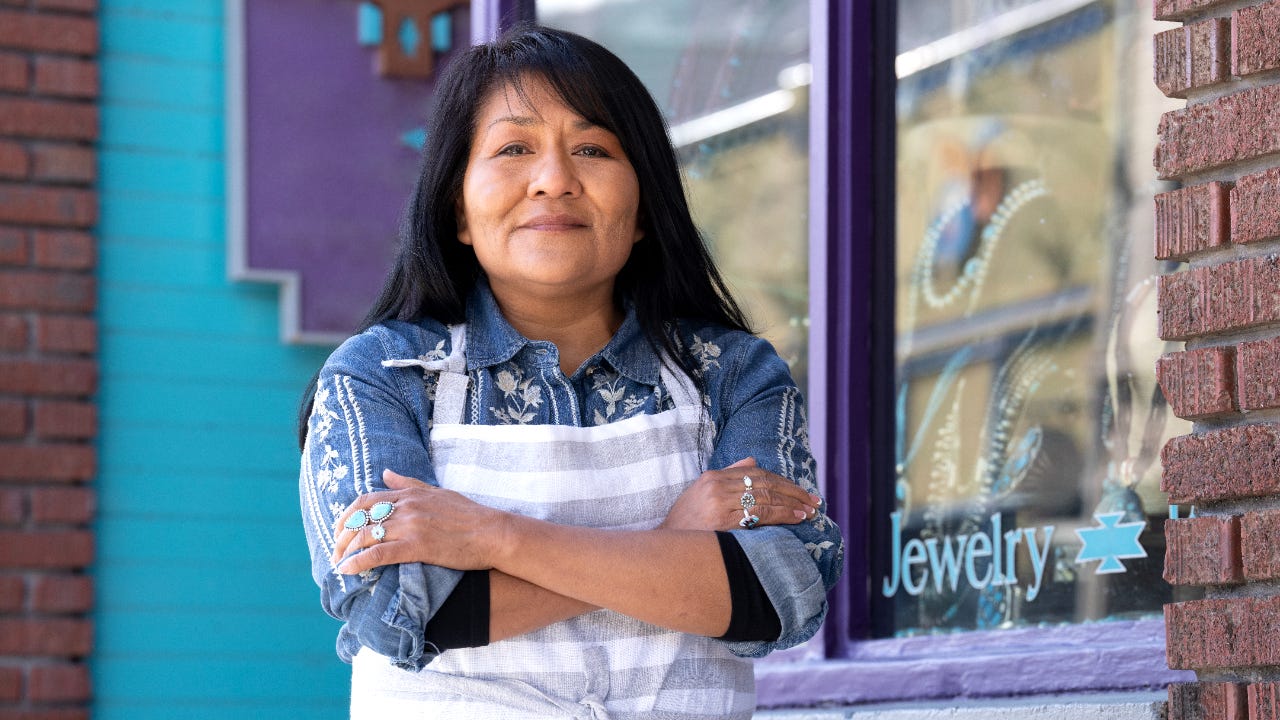Indigenous small business owner statistics

The Bankrate promise
At Bankrate we strive to help you make smarter financial decisions. While we adhere to strict , this post may contain references to products from our partners. Here's an explanation for .
Key takeaways
- Indigenous-owned businesses make up a tiny share of companies across the U.S.
- Less than 1% of SBA 7(a) and 504 loans go to Indigenous business owners each year
- Several programs — including grants — can help Indigenous-owned businesses succeed
If you look at small business owner statistics across the country by ethnicity, one group is significantly smaller. According to the 2022 Small Business Credit Survey by the Federal Reserve Banks, less than 1 percent of all businesses in the U.S. are Indigenous-owned. However, several nationwide programs aim to change that, and statistics show that the percentage may grow as access to capital and resources increases.
If you want to know the state of Indigenous-owned businesses in 2023 and what’s available to help new and existing companies thrive, you’re in the right place.
What is an Indigenous-owned business?
To some extent, it depends on who you ask.
While U.S. surveys (including those conducted by the Census Bureau) often identify Indigenous people as Native Americans and Alaska Native people, some groups include Native Hawaiians in their scope. The Minority Business Development Agency (MBDA), for example, has historically grouped projects under the umbrella of American Indian, Alaska Native and Native Hawaiian (AIANNH).
For the purposes of this conversation, we’ll go with the Census Bureau’s designation and say an Indigenous-owned business is one that is Native American or Alaska Native-owned. If we include Native Hawaiian business owner demographics, we’ll specifically call it out.
Indigenous-owned business statistics
The Census Bureau, Federal Reserve and Small Business Administration provide annual data and demographics of small businesses in the United States.
Census Bureau Annual Business Surveys
When the Census Bureau released its 2020 Annual Business Survey (ABS) results, it revealed there were just over 26,000 Indigenous-owned businesses across the country. Those companies employed more than 215,000 people and brought in $35.8 billion in receipts.
Businesses owned by Native Hawaiians and Other Pacific Islanders tallied 7,331, employing more than 51,000 people and bringing in $8.5 billion.
More recently, the Bureau released preliminary data on the characteristics of businesses from the 2022 ABS, showing an increase in Indigenous-owned businesses in the United States. Data shows in 2021:
- 48,582 Indigenous-owned businesses with $54.4 billion in receipts, employing 307,933 people.
- 8,324 Native Hawaiian and Other Pacific Islander-owned businesses with $10.5 billion in receipts, employing 53,277 people.
Federal Reserve 2022 Small Business Credit Survey
All 12 Federal Reserve Banks come together for this nationwide survey. The 2023 Report on Employer Firms is a compilation of results from the 2022 Small Business Credit Survey (SBCS).
That report and the full 2022 data reveal some small business statistics for Indigenous owners worth calling out:
- Indigenous business owners make up less than 1% of all business owners
- 40% of all Indigenous-owned businesses are 0 to 2 years old
- 50% of polled Indigenous firms had less than $25,000 in outstanding debt
- 51% of Indigenous-owned businesses got all or most of the financing they applied for, but 44% got none at all
- 23% of Indigenous business owners said the current financial condition of their company was poor; 49% said it was fair
- The most popular type of financing among Indigenous-owned companies was lines of credit (53%) from large banks (48%)
- 37% of Indigenous-owned businesses were operating at a loss at the end of 2021
- The most popular reason for seeking financing was meeting operating expenses (79%), followed by pursuing new business opportunities (64%)
- Just 56% of Indigenous-owned businesses relied on funds from owners’ personal savings, friends or family in the last five years, the lowest percentage among any group
Notably, footnotes from the report call out that Indigenous-owned businesses were excluded from charts showing the approval rates of applicants who sought loans, lines of credit and cash advances because the sample size was too small.
Small Business Administration lending report
The SBA lending report is updated weekly. It shows approval rates based on business owner demographics for 7(a) and 504 loans from the Small Business Administration (SBA).
Indigenous business owners make up a tiny portion of both loan programs.
So far, in 2023, only 43 Indigenous-owned businesses have been approved for a 504 loan. That makes up just 0.7 percent of all 504 loan approvals. For 7(a) loans, 486 Indigenous business owners have been approved for roughly $238,000,000. That accounts for just 0.8% of all 7(a) approvals and 0.9% of distributed 7(a) dollars.
Still, though, there is a positive note worth mentioning. While that’s a tiny share, it’s an improvement over the 379 7(a) approvals Indigenous business owners saw for just over $192,000,000 in 2022.
Looking further into the SBA’s lending report shows disparities in SBA funding for minorities and women.
In 2022, white business owners received 60.4 percent of 504 loan approvals, whereas Native American and Alaska Native business owners only received 0.7 percent. Male business owners received 63.8 percent of 504 loan approvals, whereas women-owned businesses received 36.2 percent. Data for 7(a) loans show similar trends.
Why is it more difficult for Indigenous-owned businesses to receive funding?
According to a report in 2021 from the U.S. Department of Commerce and the Minority Business Development Agency focusing on business development on tribal reservations, several economic and socioeconomic factors impact Native American business development.
In many instances, tribal reservations have the same economic disadvantages that rural or remote areas in the United States face. Access to the internet, outside capital, a skilled workforce and the labor market all impact the development of Native American businesses.
The report also notes that educational attainment and access to a computer and the internet are key factors in economic and business development. The study concludes that only when policies surrounding these areas are created or self governance occurs will it be easier for Indigenous-owned businesses to succeed and access the resources and opportunities that non-minority business owners typically have.
Furthermore, a report by the MBDA in 2010 found that minority-owned businesses lacked access to financial, human and social capital. They note that minority-owned businesses often pay higher interest rates on loans and are more likely to be denied credit and business loans. It also states that many minority-owned businesses are less likely to apply for financing because they fear being denied.
The 2023 Report on Startup Firms Owned by People of Color by the Federal Reserve Banks also found that while startups owned by people of color aim to scale and grow, they typically are less likely than white-owned startups to receive or be fully approved for funding, which is critical for a new business.
Resources available to Indigenous businesses
Even though it is more difficult to receive funding, there are dedicated resources for Indigenous-owned businesses. If you’re a Native American, Alaska Native, Native Hawaiian or Other Pacific Island business owner, you likely qualify for a wide range of grants for minority-owned businesses.
Beyond that, there are some Indigenous-focused programs you can explore, including:
- Native American Business Development Institute (NABDI) grant
- MBDA’s American Indian, Alaska Native, and Native Hawaiian (AIANNH) projects
- Indian Loan Guarantee and Insurance Program (ILGP), which backs loans to Native American and Alaska Native-owned business
- SBA’s Office of Native American Affairs (ONAA)’s technical assistance resources
- Empowerment workshops through Sister Sky and the SBA
And if you’re thinking of starting your own business as an Indigenous person, you might benefit from the Indian Business Incubators Program (IBIP).
SCORE also offers workshops, courses and support for small businesses, with its mission highlighting diversity, equity and inclusion.
The U.S. government has recently dedicated more funding to Tribal small businesses as it’s estimated there was a 40 percent decline in Native American-owned businesses after the COVID-19 pandemic.
Additionally, the SBA has enacted rule changes, expanding lenders eligible for SBA loans — making loans more widely available to underserved communities — and allowing Community Advantage lenders to continue serving minority communities permanently.
How to support Indigenous-owned businesses
If these small business owner statistics have you wondering how you can help to increase the number of Indigenous business enterprises across the country, you can take action.
First, as a consumer, your dollar can go a long way. Whether you’re looking for a gift or something practical for your own use, seek it out from an Indigenous-owned business. To help you there, we recommend looking at roundups like the ones from:
Apart from purchasing goods from Indigenous-owned small businesses, you could donate to Indigenous-led nonprofits to help support and uplift communities.
You can also use your voice to highlight Indigenous business owners and their companies. Tell your friends and family about them, or use your social media channels to spread the word.
Bottom line
Ultimately, small business statistics show that Indigenous-owned businesses account for a tiny sliver of companies nationwide. And they get a proportionally tiny share of the financing they need to grow.
Fortunately, resources like grant programs and educational workshops can help Indigenous business owners find success in 2023 and beyond. Ideally, if these programs function as they should, stats in future years will show a growing number of Indigenous-owned businesses.
Frequently asked questions
-
Specific small business owner statistics are hard to come by because many businesses don’t report how many owners are in their business. That said, we know that more than 26,064 Indigenous-owned businesses exist today.
-
For a business to be considered minority-owned, it has to be at least 51 percent owned, operated or controlled by someone from an ethnic, gender or military-based minority group. So, for example, a business could be considered minority-owned if it’s a sole proprietorship run by a woman, veteran or Native American.
-
Several resources exist to help uplift Indigenous- and minority-owned businesses. The Minority Business Development Agency, the U.S. Department of Commerce, the Small Business Administration and various other nonprofits and private organizations work to uplift minority communities and small businesses. Apart from support and tools to assist in starting a business, grants and minority-focused programs and projects exist to ensure Indigenous- and minority-owned businesses succeed.
Related Articles




Study: Racial biases continue to impact loan approvals for minority business owners